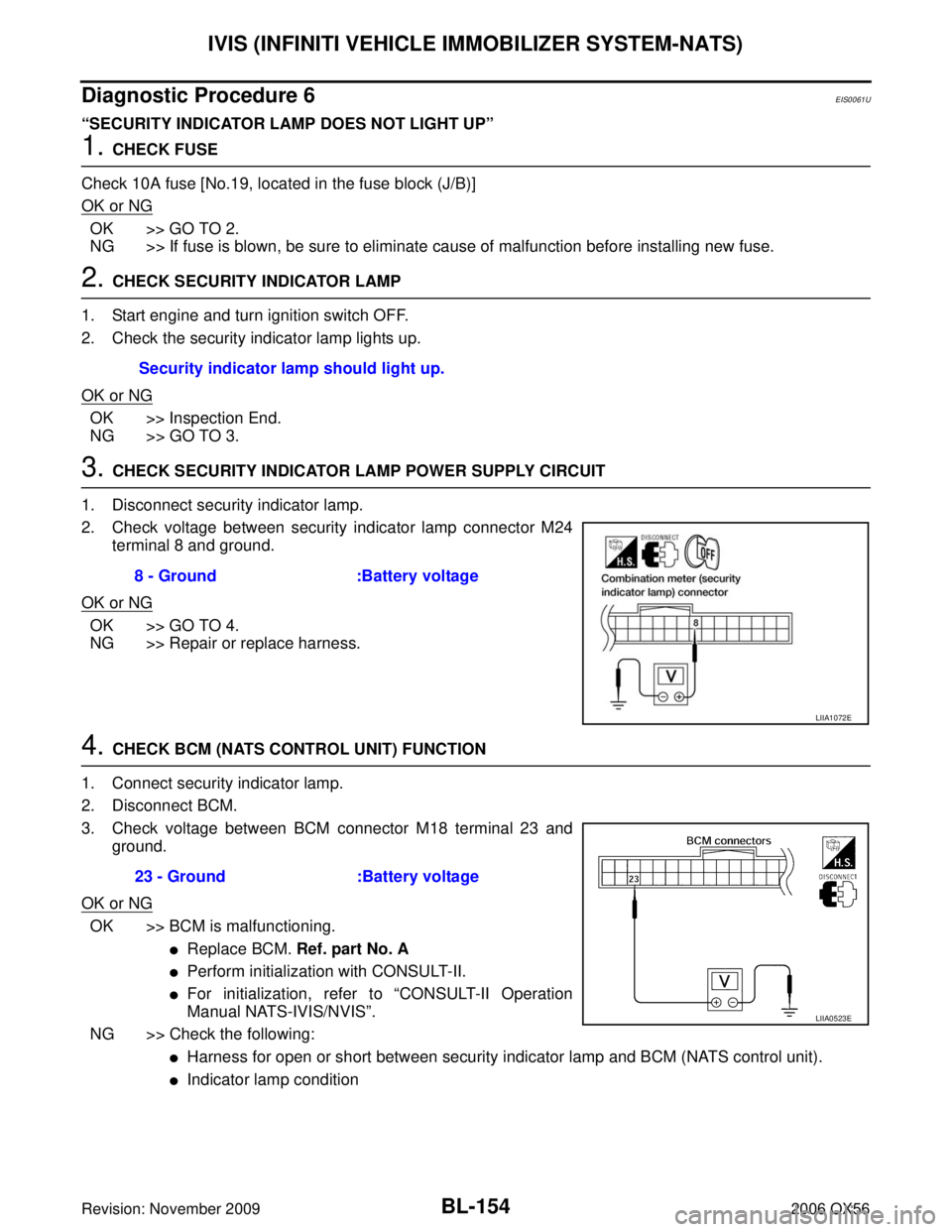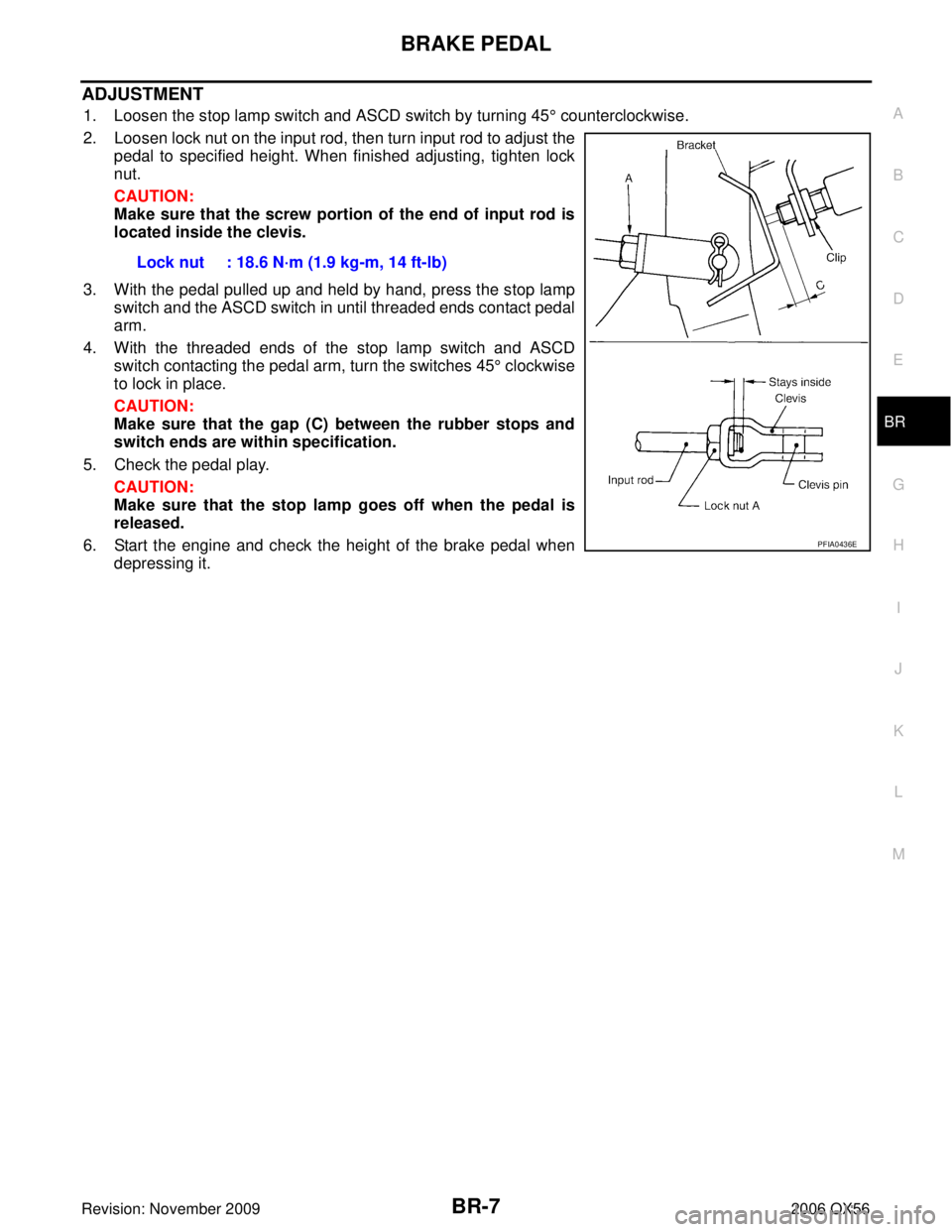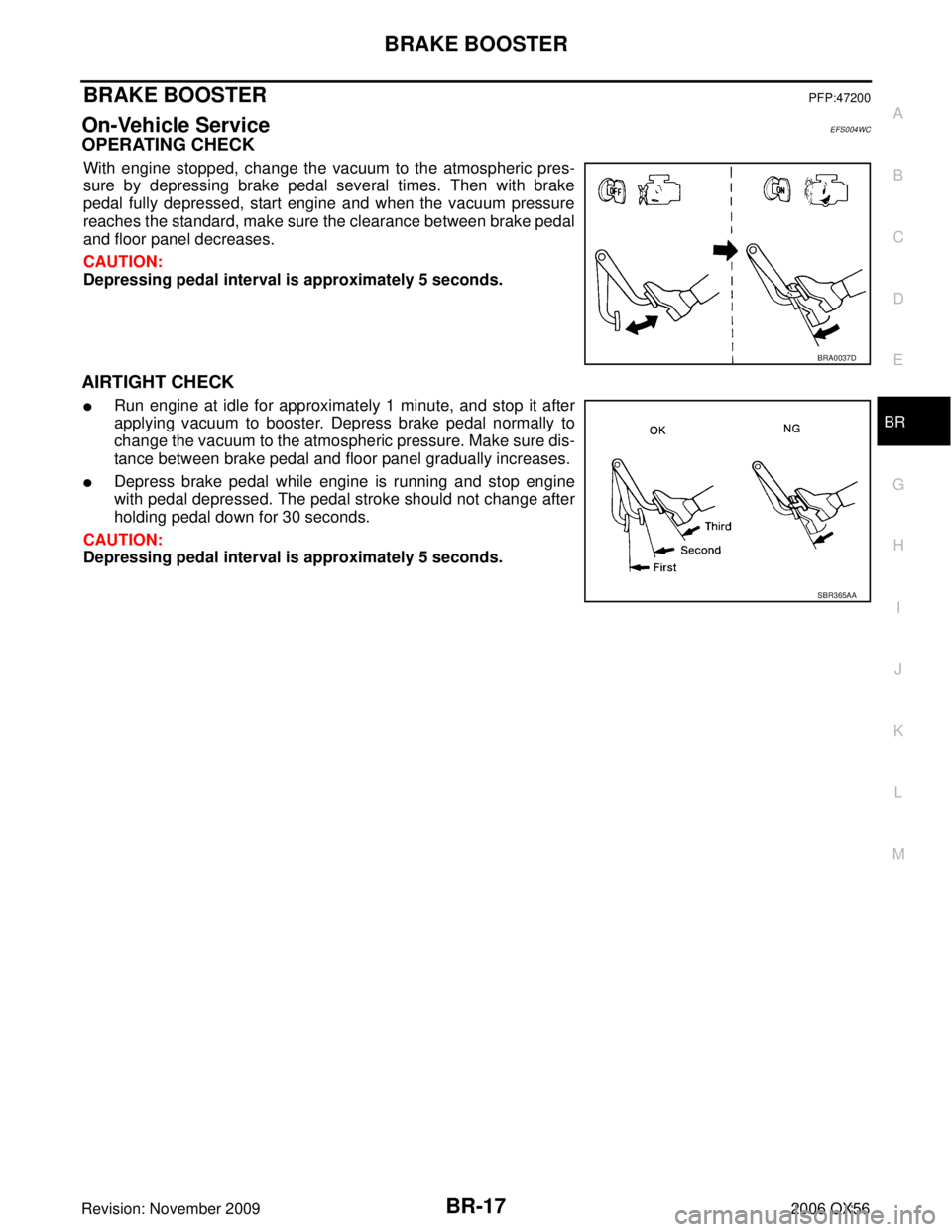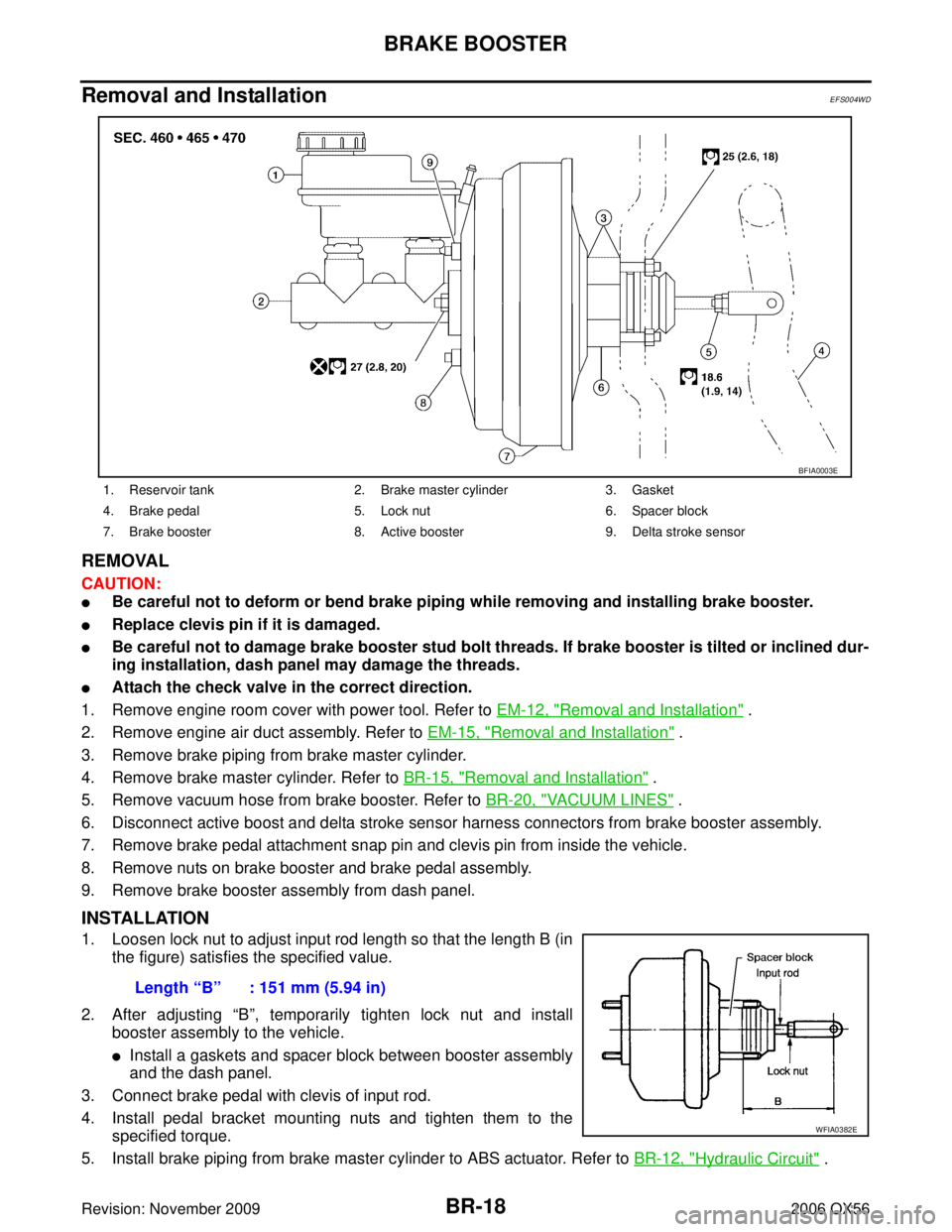Page 935 of 3383

BL-154
IVIS (INFINITI VEHICLE IMMOBILIZER SYSTEM-NATS)
Revision: November 20092006 QX56
Diagnostic Procedure 6EIS0061U
“SECURITY INDICATOR LAMP DOES NOT LIGHT UP”
1. CHECK FUSE
Check 10A fuse [No.19, located in the fuse block (J/B)]
OK or NG
OK >> GO TO 2.
NG >> If fuse is blown, be sure to eliminate cause of malfunction before installing new fuse.
2. CHECK SECURITY INDICATOR LAMP
1. Start engine and turn ignition switch OFF.
2. Check the security indicator lamp lights up.
OK or NG
OK >> Inspection End.
NG >> GO TO 3.
3. CHECK SECURITY INDICATOR LAMP POWER SUPPLY CIRCUIT
1. Disconnect security indicator lamp.
2. Check voltage between security indicator lamp connector M24 terminal 8 and ground.
OK or NG
OK >> GO TO 4.
NG >> Repair or replace harness.
4. CHECK BCM (NATS CONTROL UNIT) FUNCTION
1. Connect security indicator lamp.
2. Disconnect BCM.
3. Check voltage between BCM connector M18 terminal 23 and ground.
OK or NG
OK >> BCM is malfunctioning.
�Replace BCM. Ref. part No. A
�Perform initialization with CONSULT-II.
�For initialization, refer to “CONSULT-II Operation
Manual NATS-IVIS/NVIS ”.
NG >> Check the following:
�Harness for open or short between security indicator lamp and BCM (NATS control unit).
�Indicator lamp condition
Security indicator lamp should light up.
8 - Ground
:Battery voltage
LIIA1072E
23 - Ground :Battery voltage
LIIA0523E
Page 956 of 3383
BODY REPAIRBL-175
C
DE
F
G H
J
K L
M A
B
BL
Revision: November 2009 2006 QX56
ENGINE COMPARTMENT
MEASUREMENT
WIIA0551E
Page 999 of 3383
BR-6
BRAKE PEDAL
Revision: November 20092006 QX56
BRAKE PEDALPFP:46501
Inspection and Adjustment EFS0068P
INSPECTION
1. Inspect the brake pedal free height "H" from the lower dash panel using tool.
2. Adjust the height referring to the following specifications.
CAUTION:
When equipped with adjustable pedal, the pedal must be in
the forwardmost (closest to the floor) position for pedal
height measurement.
Brake Pedal Specifications
Unit: mm (in)
Tool number : — (J-46532)
WFIA0160E
Free height "H" : 182.3 - 192.3 mm (7.18 - 7.57 in)
Depressed pedal height "D" [under a force of 490 N (50 kg-f, 110 lb-f) with engine
running] : More than 90.3 mm (3.55 in)
Clearance between pedal stopper and threaded end of stop lamp switch and
ASCD switch "C
1 " or “ C2 ” : 0.74 - 1.96 mm (0.029 - 0.077 in)
Pedal play "A" : 3 - 11 mm (0.12 - 0.43 in)
Page 1000 of 3383

BRAKE PEDALBR-7
C
DE
G H
I
J
K L
M A
B
BR
Revision: November 2009 2006 QX56
ADJUSTMENT
1. Loosen the stop lamp switch and ASCD switch by turning 45° counterclockwise.
2. Loosen lock nut on the input rod, then turn input rod to adjust the pedal to specified height. When finished adjusting, tighten lock
nut.
CAUTION:
Make sure that the screw portion of the end of input rod is
located inside the clevis.
3. With the pedal pulled up and held by hand, press the stop lamp switch and the ASCD switch in until threaded ends contact pedal
arm.
4. With the threaded ends of the stop lamp switch and ASCD switch contacting the pedal arm, turn the switches 45 ° clockwise
to lock in place.
CAUTION:
Make sure that the gap (C) between the rubber stops and
switch ends are within specification.
5. Check the pedal play. CAUTION:
Make sure that the stop lamp goes off when the pedal is
released.
6. Start the engine and check the height of the brake pedal when depressing it.Lock nut : 18.6 N·m (1.9 kg-m, 14 ft-lb)
PFIA0436E
Page 1007 of 3383
BR-14
BRAKE PIPING AND HOSE
Revision: November 20092006 QX56
Inspection After InstallationEFS004W8
CAUTION:
If a leak is detected at the connections, retighten it or, if necessary, replace the damaged part.
1. Check brake tubes and hose connections for fluid leaks, damage, twist, deformation, contact with other
parts, and loose connections. Replace any damage parts.
2. While depressing brake pedal under a force of 785 N (80 kg-f, 177 lb-f) with engine running for approxi- mately 5 seconds, check for fluid leakage from each part.
Page 1010 of 3383

BRAKE BOOSTERBR-17
C
DE
G H
I
J
K L
M A
B
BR
Revision: November 2009 2006 QX56
BRAKE BOOSTERPFP:47200
On-Vehicle ServiceEFS004WC
OPERATING CHECK
With engine stopped, change the vacuum to the atmospheric pres-
sure by depressing brake pedal several times. Then with brake
pedal fully depressed, start engine and when the vacuum pressure
reaches the standard, make sure the clearance between brake pedal
and floor panel decreases.
CAUTION:
Depressing pedal interval is approximately 5 seconds.
AIRTIGHT CHECK
�Run engine at idle for approximately 1 minute, and stop it after
applying vacuum to booster. Depress brake pedal normally to
change the vacuum to the atmospheric pressure. Make sure dis-
tance between brake pedal and floor panel gradually increases.
�Depress brake pedal while engine is running and stop engine
with pedal depressed. The pedal stroke should not change after
holding pedal down for 30 seconds.
CAUTION:
Depressing pedal interval is approximately 5 seconds.
BRA0037D
SBR365AA
Page 1011 of 3383

BR-18
BRAKE BOOSTER
Revision: November 20092006 QX56
Removal and InstallationEFS004WD
REMOVAL
CAUTION:
�Be careful not to deform or bend brake piping while removing and installing brake booster.
�Replace clevis pin if it is damaged.
�Be careful not to damage brake booster stud bolt threads. If brake booster is tilted or inclined dur-
ing installation, dash panel may damage the threads.
�Attach the check valve in the correct direction.
1. Remove engine room cover with power tool. Refer to EM-12, "
Removal and Installation" .
2. Remove engine air duct assembly. Refer to EM-15, "
Removal and Installation" .
3. Remove brake piping from brake master cylinder.
4. Remove brake master cylinder. Refer to BR-15, "
Removal and Installation" .
5. Remove vacuum hose from brake booster. Refer to BR-20, "
VACUUM LINES" .
6. Disconnect active boost and delta stroke sensor harness connectors from brake booster assembly.
7. Remove brake pedal attachment snap pin and clevis pin from inside the vehicle.
8. Remove nuts on brake booster and brake pedal assembly.
9. Remove brake booster assembly from dash panel.
INSTALLATION
1. Loosen lock nut to adjust input rod length so that the length B (in the figure) satisfies the specified value.
2. After adjusting “B”, temporarily tighten lock nut and install
booster assembly to the vehicle.
�Install a gaskets and spacer block between booster assembly
and the dash panel.
3. Connect brake pedal with clevis of input rod.
4. Install pedal bracket mounting nuts and tighten them to the specified torque.
5. Install brake piping from brake master cylinder to ABS actuator. Refer to BR-12, "
Hydraulic Circuit" .
1. Reservoir tank 2. Brake master cylinder 3. Gasket
4. Brake pedal 5. Lock nut 6. Spacer block
7. Brake booster 8. Active booster 9. Delta stroke sensor
BFIA0003E
Length “B” : 151 mm (5.94 in)
WFIA0382E
Page 1012 of 3383
BRAKE BOOSTERBR-19
C
DE
G H
I
J
K L
M A
B
BR
Revision: November 2009 2006 QX56
6. Connect active boost and delta stroke sensor harness connectors to brake booster assembly.
7. Connect vacuum hose to brake booster.
8. Install master cylinder to booster assembly. Refer to BR-18, "
Removal and Installation" .
9. Adjust the height and play of brake pedal.
10. Tighten lock nut of input rod to specification.
11. Install engine air duct assembly. Refer to EM-15, "
Removal and Installation" .
12. Install engine room cover with power tool. Refer to EM-12, "
Removal and Installation" .
13. Refill with new brake fluid and bleed air. Refer to BR-11, "
Bleeding Brake System" .